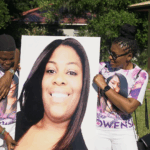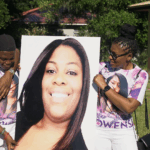
A critically acclaimed new documentary’s “subversive” use of bodycam and CCTV footage helps it detail a shocking neighbourhood incident that became international news.
A new documentary explores a tragic incident that occurred in Florida in June 2023, when a white woman, Susan Lorincz, shot her black neighbour, Ajike Owens, through a locked front door, claiming she was in fear for her life. Lorincz later received a 25-year prison sentence for Owens’s manslaughter. The Perfect Neighbour, directed by Geeta Gandbhir, has been praised by film critics for its groundbreaking approach, as around 90% of it consists of police body camera and CCTV footage. It shows the build-up to the shooting and Lorincz’s increasing hostility towards her community.
The moment 58-year-old Susan Lorincz is arrested in June 2023 is shown in The Perfect Neighbour through CCTV cameras located in the police interview room in Marion County, Florida. She issues denial after denial to their requests to stand up, be handcuffed, and go with police officers. “No. I can’t. I’m sorry,” she says repeatedly. Minutes tick by, all of them shown on camera, while three officers persuade her to go voluntarily with them.
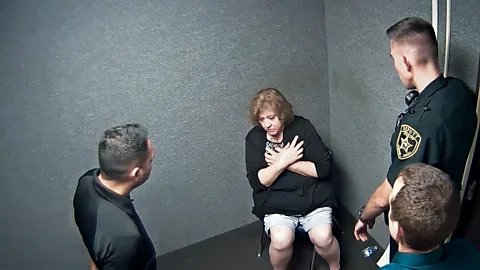
Until that interview, Susan Lorincz had been a free woman, not under arrest, despite a few days earlier firing a gun at her neighbour through a locked metal front door. Thirty-five-year-old Ajike Owens, known as AJ, was a restaurant manager and single mother of four children. Audiences learn through that interview that only two minutes before the shooting on 2 June 2023, Lorincz had called police to her house, because she and one of Owens’s children had had a dispute over an electronic tablet. Lorincz tells police that during those two minutes, Owens had banged on Lorincz’s door, shouting that she would kill her, and the older woman shot “in fear for my life”. Lorincz continues to maintain from jail that she fired her gun out of fear, although sentencing her, the judge told her he believed the shooting was prompted “more by anger than fear”.
Our mantra as a film team was really ‘show and not tell’. You don’t have to beat audiences over the head with advocacy – Geeta Gandbhir
Director Geeta Gandbhir’s reconstruction of events has no narration and doesn’t rely on witness interviews, but instead on a doorbell camera, which captures the sound of a shot being fired, and Owens’s son screaming to call 911. Police body cameras track paramedics trying to help Owens after she is shot. Later cameras follow, unrelentingly, as the children’s father breaks the news to them that their mother “isn’t coming back”. And cameras inside the police car show Susan Lorincz, not under arrest, sitting in the back, while a neighbour shouts, “why did you do it?”
Gandbhir tells the BBC that the footage first came to her as she was a family friend of Owens’s. Lawyers acting for the Owens family had requested the material from the police, and the family wanted to know if there might be anything to keep the case in the news. “There was about thirty hours of video about the case, including doorbell camera, bodycam and cell phone footage, detective interviews with people in the community, as well as audio recordings from Susan’s conversations with the police, when she had called them many, many, many times,” Gandbhir says. “It was a mess, but we managed to get through it, and that’s when I realised it might be a film.”
The footage shows that the first time police officers were called to Lorincz’s address because of a dispute with Ajike Owens was in February 2022, when Lorincz claimed that Owens had thrown a “No Trespassing” sign that belonged to Lorincz at her and hit her on the leg (Owens said that she had thrown it on the ground and was not aiming it at her neighbour.) No one was arrested.
Police are called out several times through the following year, as Lorincz makes emergency calls complaining that local kids, including Owen’s children, are tormenting her. “I’m a single woman, I work from home, I’m peaceful, I’m the perfect neighbour,” Lorincz says in another call to the police, when she’s complaining about neighbourhood children playing football on the grass near her house.
In the documentary footage, the local children appear to dislike Lorincz (they call her “the Karen”, a pejorative term for a middle-aged woman, usually white, who is perceived as entitled). The footage also shows that they tell officers Lorincz called them a “jack-a” (for “jackass”) and refuse to repeat the entire word. In contrast to Lorincz’s alienation from her community, her multiracial neighbours seem close, looking after each other’s children (they would later testify against Lorincz.)
A fly-on-the-wall perspective
Writing in Variety, film critic Peter Debruge calls the film “revolutionary” for what it achieves with such footage; indeed, its narrative depth won Geeta Gandbhir the best documentary director award at this year’s Sundance Film Festival. The Los Angeles Times calls it “on the most visceral level, a documentary horror film built with police footage, [but] it also reveals how a violent tragedy can be unwittingly manifested by unchecked grievance”.
I believe that the film does a great justice in highlighting the differences of how people of colour and then their counterparts are treated differently – Pamela Dias
“I come from a narrative background, and I wanted this film to play like a thriller so people would remain engaged and immersed,” Gandbhir says. “Our mantra as a film team was really ‘show and not tell’. You don’t have to beat audiences over the head with advocacy.
“I wanted to take people on a journey that embeds them within this community, like they were a fly on the wall. I think about the UK series Adolescence, although it came out after our film was made. It’s the same idea: you allow things to unfold, and for people to live within it and come to their own conclusions about why this happened.”
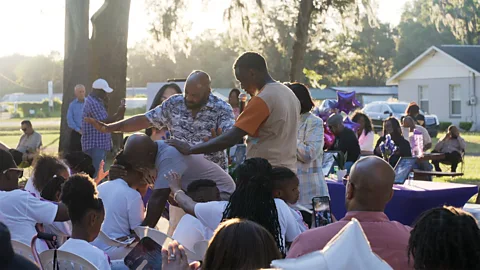
Racism was found to be a motive for Lorincz’s hatred of the Owens family. CCTV footage in the film shows her confessing to police that she used a racial slur when speaking with the Owens children, and at the trial, neighbours testified that Lorincz called one of the children a different racist term on the night of the shooting.
Lorincz’s trial made international headlines partly because of controversy over Florida’s so-called “Stand Your Ground” law. It allows, in some cases, for deadly force to be used as self-defence, which, it’s been reported, is disproportionately negative for African Americans. In 2012, 17-year-old Trayvon Martin, a black teenager from Florida, was fatally shot by George Zimmerman, who claimed self-defence and was not arrested for days. Zimmerman was later acquitted of murder. Protests were held over Martin’s killing across the US.
Susan Lorincz also remained free for five days while police investigated her claim of self-defence. She was charged with manslaughter with a weapon, as it was ruled there was insufficient evidence to charge her with murder.
‘Subverting the narrative’
Ajike Owens’s mother, Pamela Dias, tells the BBC that the film allows audiences to question why Lorincz was not arrested immediately. “I believe that the film does a great justice in highlighting the differences of how people of colour and their counterparts are treated differently,” she says. “Had the roles been reversed, I believe an arrest would have been made at once. My daughter was murdered through a locked metal door. She had not made an entry, and this all stemmed from children playing in an open field where they were permitted to by the owner. Susan was fuelled by hatred and racism, and the film unfolds all of that and even more.”
At the time, however, authorities in Florida defended their decision not to arrest Susan Lorincz immediately, saying no arrest could be made because of the state’s “Stand Your Ground” laws unless it was proved she did not act in self-defence. “The laws here in the state of Florida are clear,” Marion County Sheriff Billy Woods said. “I may not like them. I may not agree with them. But I will follow”.
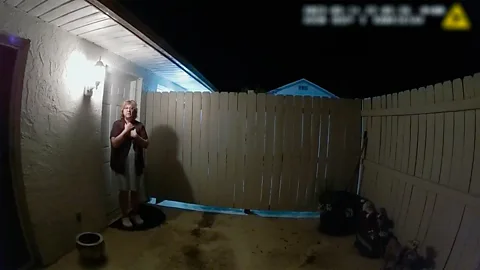
The documentary shows Lorincz telling officers, when they came to question her on a separate incident, that she was sexually abused when she was younger by her father. She was diagnosed with PTSD, but that was ruled not to be a mitigating factor in her sentencing.
“People might watch the film and think, ‘oh she’s mentally not well’,” says Gandbhir, “but she was evaluated and that was not the case. I think you see that actually she was very confident about thinking she was going to get off. She believed the police were on her side and she was in the right. And I think it was in that only her second police interview where she finally realised that her story wasn’t going to hold up. And then you see her disassociate and refuse to get up, but you see who she really is there.”
While police bodycams are now frequently used in true crime TV shows, including a 2018 series simply called Bodycam, documentary film-making hasn’t made the same extensive use of them, although 2021’s All Light Everywhere by Theo Anthony immerses the viewer into the use of police cameras and the rise of a so-called “surveillance society”. Bill Morrison’s 2023 film, Incident, which was nominated for an Oscar, uses security cameras and police bodycam footage to show the killing of Harith “Snoop” Augustus by a Chicago police officer in 2018. The documentary short captures the final moments of his life and police reactions afterwards, aware that they’re on camera.
More like this:
• Why Mr Scorsese is a must-watch
• How The Social Network predicted the future
• 12 of the best films to watch in October
The officers captured in The Perfect Neighbor, by contrast, are intent on de-escalating tensions, which makes Gandbhir’s use of the bodycam footage “subversive”, according to the New Yorker film critic Justin Chang. “She uses it not to reconstruct a crime,” he writes, “but, rather, to bring to light the hidden drama of a neighourhood. The simple spectacle of children at play, it seems, is all it takes to transform a patch of American suburbia into a gaping, microcosmic wound of racism, paranoia, aggression, mental illness, and gun violence.”
Gandbhir agrees that she wanted to “subvert” the perception of police body cameras as part of law enforcement, explaining that “for people of colour, police bodycam footage is often a violent tool that is steeped in institutional racism, often used to justify police violence, as we saw in cases such as George Floyd’s. We wanted to flip that on its head. I wanted to subvert that narrative with this film and use it differently instead to humanise this community.
“And I do believe that, as people are seeing it as police bodycam footage, they will believe it. It’s coming from the authorities, but again, we’re using it in a way that’s not normally the case. It allows the audience to feel embedded, to feel they’re there. They’re living with this community on this journey that they went on, and feeling the horror of it all, too. The fact that one outlier with a gun changed everything for them.”
The Perfect Neighbour is on Netflix from 17 October.
- President Commissions 36.5 Million Dollars Hospital In The Tain District
- You Will Not Go Free For Killing An Hard Working MP – Akufo-Addo To MP’s Killer
- I Will Lead You To Victory – Ato Forson Assures NDC Supporters
Visit Our Social Media for More

